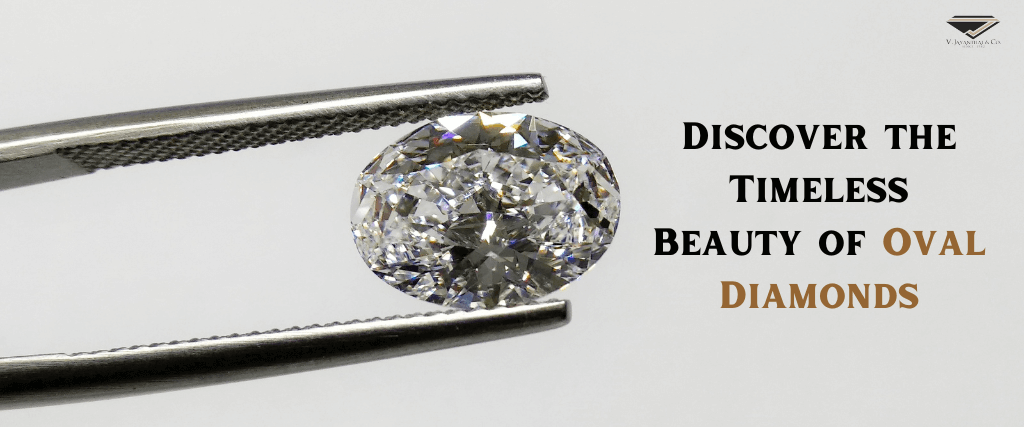
One of those timeless cuts, The Oval diamond, needs little introduction. Similar to the Round diamond, it is capable of speaking for itself and persuading many customers that it is the best option for them. Contrary to the round, it's a fantastic form to take into account if you want to deviate from "the norm" without going too far in the other direction. An oval diamond features an extended round form with a unique twist on understated beauty. Its fire may equal that of a round brilliant when it is faceted in a brilliant manner. The most typical facet configuration for an oval diamond is eight bezel facets on the crown and eight primary facets on the pavilion.
Oval diamonds are popular with many individuals for the following persuasive reasons: Oval diamonds might look bigger to the eye than round diamonds of the same carat weight because they have a larger surface area. The finger may appear longer due to the oval shape. In addition, because an oval diamond lacks sharp angles or corners, it is less likely to chip than other exquisite shapes. Obviously, there’s a lot more to know about the Oval cut than that, but extolling the virtues of this classic cut is certainly a great place to start.
One of the earliest types of diamonds is the oval. Lazare Kaplan, a Russian diamond cutter, improved the form in the 1960s. For the most dazzling, full-of-fire oval-cut diamond, he invented the cutting technique still in use today. Before designing the Modern Oval Cut, Kaplan gained a reputation for his extraordinary talents in cleaving, a procedure in which fractured or terribly defective diamonds are cut into smaller, minimally included gems. Inarguably one of the best-known diamonds in the world, the Koh-I-Noor, or ‘mountain of light, has featured an Oval cut since the mid-nineteenth century. Weighing 105.602 carats, the diamond is now in the possession of Queen Elizabeth II and resides in the Tower of London. Thousands of people have flocked to see it and the incredible glitter that the Oval cut offers throughout the years.
There are several options for settings for engagement rings with oval diamonds. And any option can provide a noticeably distinct appearance. Here are some options.
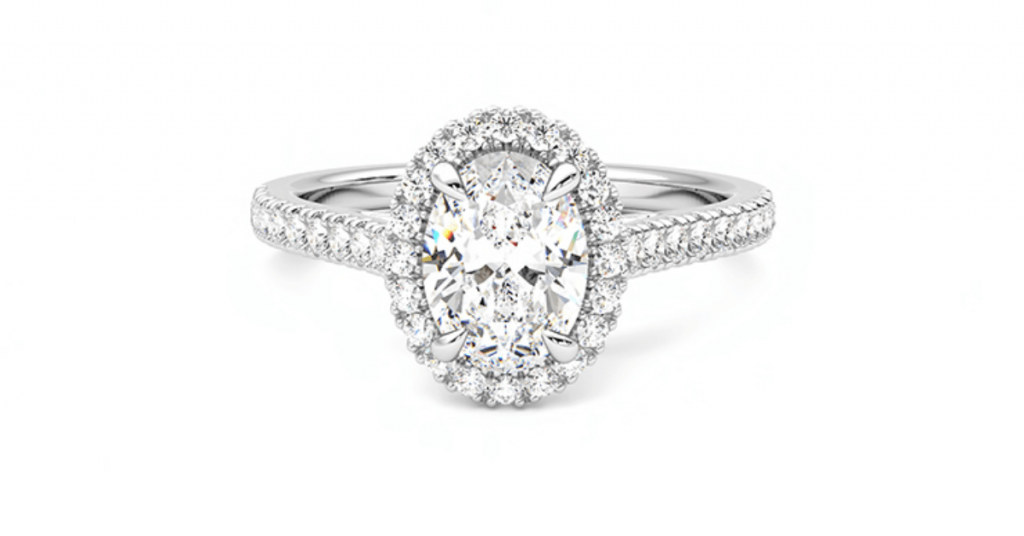
The circular centre stone is surrounded by a stunning halo of lesser diamonds. It draws attention to the form and gives the diamond a bigger appearance. A striking appearance may be achieved by selecting a unique metal colour or side stone.
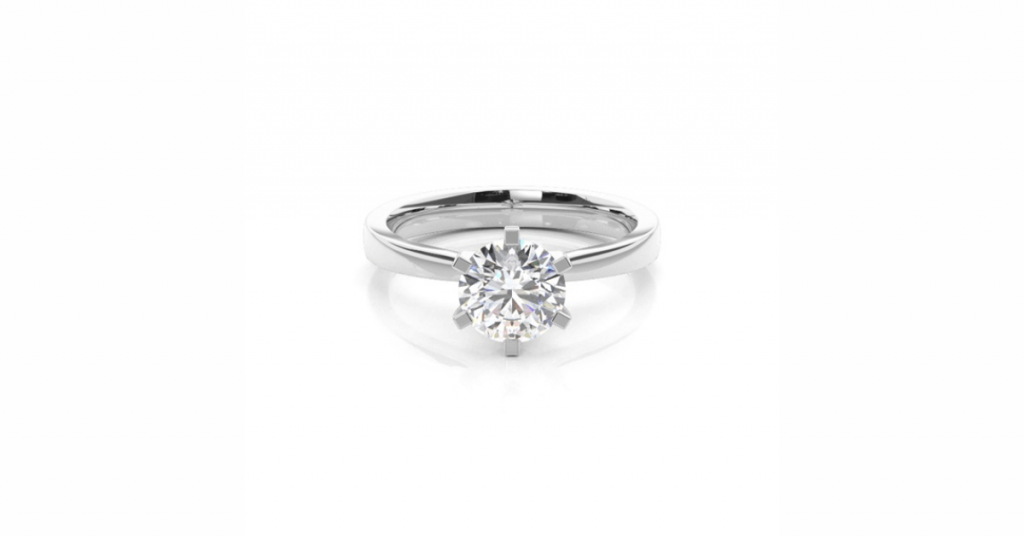
A decent setting for an oval diamond is a prong setting. They not only shield the diamond from damage, but they may also provide height, lifting the stone above the band and catching the viewer's attention.

If you lead an active lifestyle, a bezel setting, which entirely encloses the diamond's edge in metal, is an excellent option. It’s an effective way to protect the diamond and also enhances the beauty of the oval shape.
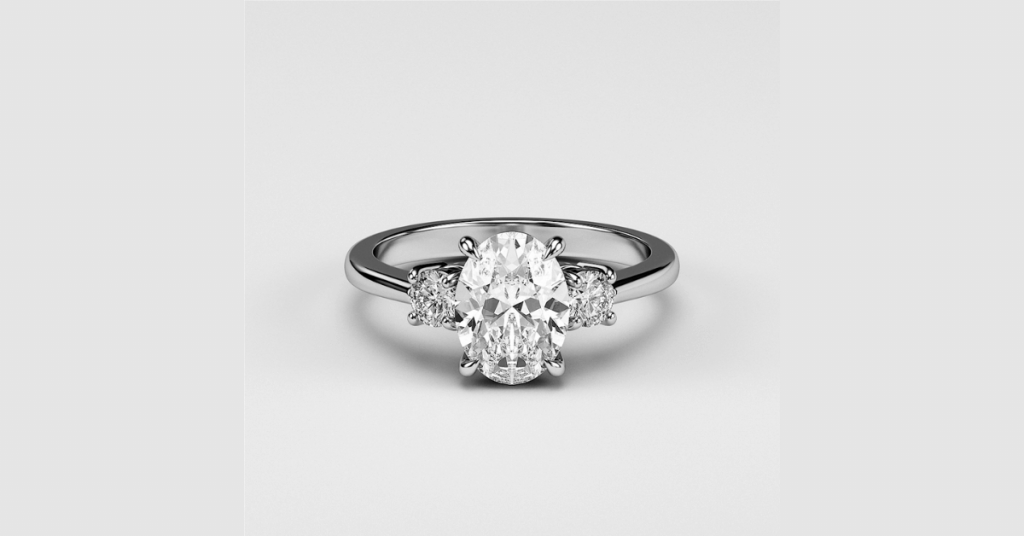
Almost any side stone looks good with an oval diamond. Its form is echoed by half-moon diamonds, which makes them a desirable option. Baguettes and tapering baguettes, as well as coloured gems, provide a chance to establish contrast. Choose side stones that are within one or two colour grades of the main diamond to avoid competing with its beauty if you want your diamond side stones to complement the centre oval.
The most accurate determinant of a diamond's brilliance, brightness, and overall beauty is its cut, which is the most crucial C of all.
The GIA does not assign oval diamonds the same overall cut grade as it does round brilliants, like all fancy cut diamonds. But all is not lost, since there are many more statistics that may be used to describe a diamond's cut. See our table below for a starting point for cut quality.
Remember that although though statistics are an excellent place to start to weed out low-quality diamonds, your best chance is always to see a diamond in person or on video and work with a reputable jeweller to locate the finest quality diamond in your price range. Oval diamonds are particularly arbitrary, and beauty is genuinely in the eye of the beholder (rather than the numbers).
Oval cut diamonds show color more than other diamond shapes, so you'll want to opt for a higher color grade to get a certain look - whether that be cool and colorless or sunny champagne. The larger the diamond, the more obvious the color differences will be.
However, the distinctions between two (or even three) colour classes are frequently indiscernible to the unaided eye, so put your attention on choosing the diamond colour that you adore visually rather than spending more money for a barely noticeable letter grade.
Carat refers to a diamond's weight and not its size as many people believe. Thanks to their elongated shape, oval cut diamonds tend to look bigger for their carat weight vs other diamond shapes like a round cut diamond.
While sizes vary depending on how a stone is cut, a one-carat round diamond usually measures 6.5 x 6.5 mm, whereas an average oval cut diamond is usually 7.7 x 5.7mm - the extra height provides the impression that it is bigger. Therefore, think about an oval cut if you want a diamond that appears larger than its actual carat weight.
The quantity of imperfections or flaws in a diamond is referred to as clarity. The oval shape and superb cutting help oval-cut diamonds to effectively conceal flaws. This implies that you may choose a diamond with a lesser clarity grade and yet have it be eye-clean. Now you're free to spend your budget on more important factors, like cuts.
Remember that imperfections closer to the margins of the stone will be easier to conceal than those closer to the centre.
Flawless (FL): No inclusions or blemishes can be seen with 10x magnification.
Internally Flawless (IF) - With a 10x magnification, several imperfections (but no inclusions) are visible.
Very, Very Slightly Included (VVS1 and VVS2) - Under a 10x magnification, inclusions are difficult to notice.
Very Slightly Included (VS1 and VS2) - Minor inclusions can be seen under 10x magnification
Slightly Included (SI1 and SI2) - inclusions that are visible at a 10x magnification
Included (I1, I2, and I3) - Obvious inclusions under 10× magnification
When looking for an oval diamond, consult the 4Cs of diamond quality. Oval diamonds are judged for their carat weight, colour, and clarity using the same standards as round brilliants. This might help you narrow down your search.
When viewing oval diamonds, keep proportion in mind. According to a thorough study of form preferences done by GIA in 2009, consumers and industry experts tend to favour a longer oval shape. According to the poll, ovals with a length to width ratio of 1.7:1 were the most common shape. You won't often find one since it is impractical to cut such lengthy oval diamonds from the raw rough. Ovals with ratios between 1.3:1 and 1.4:1 are more common.
In order to create the beauty of an oval diamond, symmetry is crucial. Draw a line along the centre of an oval diamond to see if it is symmetrical. The two sides' faceting and form should be identical. Next, trace a hypothetical line across the oval's centre. Again, the two parts should have the same faceting and form.
Look for an oval diamond with a lovely contour and sections that are evenly spaced apart. It is beneficial to contrast many various oval diamonds in order to pick one that appeals to you.
The pavilion and crown come together at the girdle. It serves as the diamond's setting edge and defines the diamond's perimeter. Rounds and fancy shapes both use the same criteria to determine girdle thickness. Make sure to review the percentage diagram in the diamond's GIA Diamond Grading Report. Indicating whether the girdle is excessively thick or thin, the figure will display the stone's average girdle thickness percentage. Overly thick girdles can make a diamond heavier than its face-up appearance suggests, while tiny girdles can make damage like chipping more likely.
A seemingly dull or darker core that resembles a black bow tie is known as the "bow tie effect." It is a location where light leaks rather than being reflected. The bow tie effect reduces diamond brilliance, although it only shows up when the oval cut is too shallow or deep. The presence of a bow tie will drive down the price of a loose diamond. A bow tie is caused by an issue with the diamond’s facets, which causes an area of reduced light within the centre of the diamond. The facets of a diamond work like a series of mirrors to reflect light back into your eye from everywhere around you. The dark contrast you observe as you gaze at the stone is a reflection of your head and shoulders, which are obstructing light from reaching the diamond. The bow tie will be more obvious the closer your face is to the diamond. If the diamond is cut correctly, the bow tie will be small, but once you are in front of the diamond, there will always be some measure of a bow tie.
Overall, oval-cut diamond rings have a bigger, longer appearance than round brilliant diamond rings but nevertheless have a similar level of brightness and scintillation. They go well with rings that have bigger accent stones since they are beautiful and feminine. Oval diamond forms of the highest caliber are offered at competitive prices by V. Jayantilal & Co.
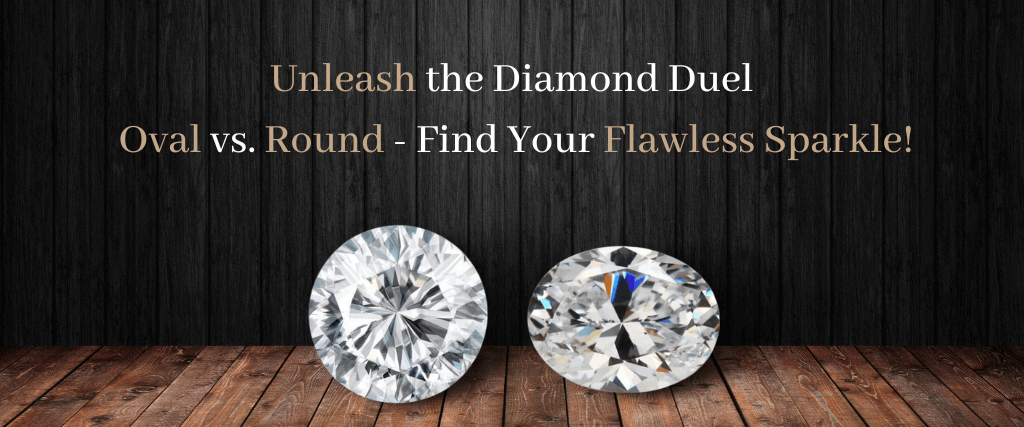
Round brilliant-cut diamonds and oval-cut diamonds rose to fame early on and are still in use today. They are a widely popular choice for engagement rings and exquisite jewellery. Whether we're talking about a naturally occurring diamond or a lab-grown diamond, these two diamond cuts both have a beautiful, elegant, and timeless form. Both diamonds work well in a variety of settings and offer a good amount of sparkle. But which should you pick? You can't go wrong with either option; we're here to tell you, but keep reading for a full breakdown of oval vs round diamond.
Oval shape diamond are the ideal choice for any woman, because of their effortless grace and elegance. It is one of the fancy-shaped diamonds and is a beauty to behold. All oval diamonds have an elongated shape, which gives them a classy appearance. It doesn't have standardized length-to-width ratios, which allows the proportions to be chosen according to personal preference. Their shape looks beautiful on any finger and often appears larger than their actual carat size, which makes an oval engagement ring popular. Additionally, compared to other diamond shapes, oval diamonds can display more colour and might have more flaws in the core of the stone.
The most common type of diamond cut is a round cut. Round diamonds have been around for centuries, but it wasn't until the first decade of the 20th century that the cut of the round form was perfected, giving rise to the round brilliant cut diamond, which has 58 facets, or flat cuts. Regarding pure optics and light performance, no shape can match the round brilliant. The round cut beautifully complements both traditional and modern engagement rings, looking great on both. Round-cut engagement rings are available in a variety of designs. With a wide range ranging from solitaire to five-stone settings, everyone may discover a ring that matches their taste.
When it comes to pricing, the 4C's of diamonds are the primary determinants of the price of a diamond. If price is your foremost priority while looking for a diamond, you can buy an oval diamond instead of a round-cut one. In addition, oval diamonds not only appear larger than round diamonds of the same carat weight but typically cost less. Due to their extreme popularity, round-cut diamonds are the most costly. Round-cut diamonds generate the most waste during the cutting process, raising the cost of these stones.
The term "carat weight" describes a diamond's size. Both oval and round diamonds are available in a wide range of carat weights. Choose an oval cut diamond if the size is important. Oval cut diamonds will appear larger than round-cut diamonds of the same carat weight because they have a larger surface area. The table's depth and size are the two most important considerations. The appropriate table percentage for a round brilliant is 54-57%, while the ideal depth percentage is 59-63%. For an oval diamond shape, the appropriate table percentage ranges from 53-63%, while the ideal depth ranges from less than 68%. The fact that oval diamonds seem bigger than round diamonds helps you make the most of your cash. Oval cut diamonds provide the appearance of longer, slenderer fingers better than round-cut diamonds, which nonetheless look stunning on any finger.
Every movement causes a diamond to shine, which is an undeniable burst of brilliance, fire, and scintillation. If sparkle is important to you, then you should choose a round cut diamond instead of an oval cut diamond. How brilliant a diamond is will depend on how well it is cut. The oval diamond is one of the most dazzling among brilliant cuts. The shape and design provide the best possible fire, brightness, and scintillation. Overall, both round and oval diamonds will glitter exquisitely, but a round brilliant is suggested if you want the most brilliance possible.
Naturally, when we talk about shape, we don't just mean the obvious—that round diamonds are round and oval diamonds are oval. Round diamonds will always be exactly that—round. After all, the shape of a circle never changes. Ovals come in a variety of shapes, including fat, wide, long, or slender. With ovals, they can vary in shape—fat, wide, long, or slender. Oval diamonds come in a variety of shapes, much like their shape itself. Therefore, when purchasing a round diamond, you should only consider the table and depth percentage rather than the diamond's form. But you must take into account the diamond's true form when purchasing an oval diamond.
When purchasing oval diamonds, one of the 4Cs to take into account is colour. Round-cut diamonds are more likely than oval cut diamonds to conceal traces of yellow or brown due to their high brilliance and sparkle. Colour isn’t inherently a negative thing in a diamond, but if you pick an oval-cut diamond and want an icy-white diamond, you’ll need to be a bit more mindful of it. Even though round brilliants cost more in general, you may not need to buy such a high colour grade. With oval diamonds, the colour grade is more significant, particularly in the lower "near-colourless" range.
By far, round brilliant diamonds are more popular. This is how the industry has shaped it. There is one oval diamond for every 25 round brilliants. Simply put, more round brilliants are made than other shapes. Oval diamonds are therefore more uncommon. All things considered, compared to other diamond shapes, oval diamonds continue to be a popular option. The oval diamond has ascended to the top of the list in recent years. Following are the current standings: oval, cushion, and round. Any of these choices will be seen as both fashionable and timeless. They are all consistently in demand, with the round brilliant at the forefront.
It is up to you and your tastes whether you choose an oval or round diamond. There is no correct or incorrect shape to select. Both of these diamond forms are timeless, will glitter magnificently, and have elegantly rounded edges that look great on any finger. Choose an oval-cut diamond if you're searching for something a little more distinctive. If you like something more classic, opt for a round-cut diamond.
At V. Jayantilal & Co., a Surat-based diamond company, you will find high-quality diamonds at the best price. There will be a ton of gorgeous, high-quality selections available for you to select from.
Please feel free to contact us if you have any questions. We are always happy to help lead you in the right direction and make your shopping experience informative and headache-free.
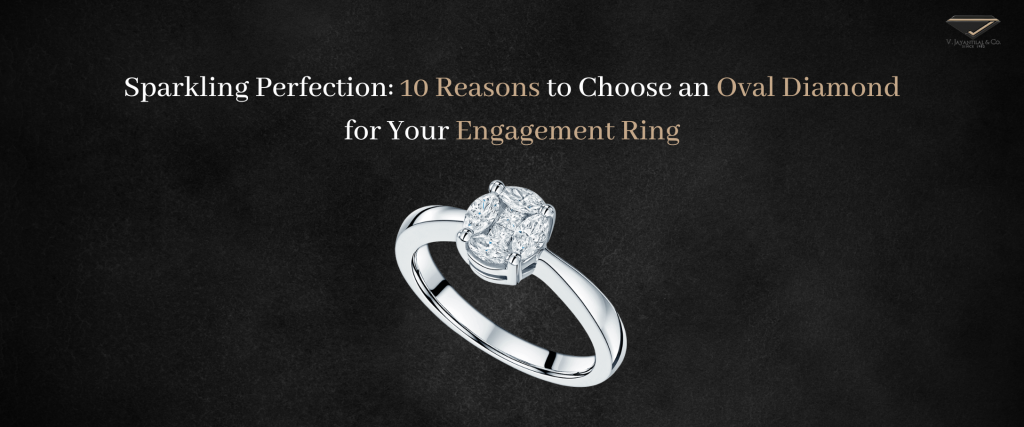
Every couple of years, a new engagement ring form gains popularity, which causes costs to increase owing to great demand. For a number of years, the title has belonged to the oval-shaped diamond engagement ring. In the realm of fine jewellery, the oval ring serves as a steady friend. oval diamond is the second most popular diamond cut after round diamond, it has a mark on day one and continues to be loved by fashion magazines and engagement ring trendsetters. The most extraordinary aspect of this traditional diamond cut is that it flatters every finger type and carat.
So, diamond oval rings are for you if you desire a large, magnificent diamond ring with exceptional brilliance and wonderful glitter! Here is the benefit of buying oval diamond engagement ring:
Oval diamonds are very similar to round diamonds in terms of brilliance and sparkle. However, an oval has a naturally elongated shape that appears more prominently on the finger. Despite having identical carat weights, the oval diamond will take up more space on the ring finger due to its elongated shape. Oval diamonds may be the most costly form on the market right now, but they're a safe and wise approach to buying oval diamond, considering you’ll receive the most for your money.
One thing to keep in mind with an oval diamond is that the color and clarity will stand out more the larger the center stone. Jewellers recommend staying between D and F on the color scale if the oval is 1.00 ct. and up. If you're searching for an eye-clean oval diamond of 1.5 ct and higher, it is advised to stick with VS1-VS2 clarity.
The apparent bow-tie configuration within an oval-cut diamond distinguishes it from other diamond forms. The oval diamond's cut prevents light from bouncing back and forth in the centre, which results in the bow tie effect. The bow tie is one of the numerous characteristics of an oval diamond that make it attractive and unique. However, in order to maintain the oval diamond's uniqueness, you must be attentive while selecting the setting. Even though an oval-cut diamond combines well with most settings, the inappropriate setting can wind up overpowering and outshining the centre stone. An oval diamond looks lovely in a halo setting, a prong setting, or a bezel setting.
Oval-cut diamonds are more unique than round-cut ones and are surprisingly cheaper. The cost climbs by a few thousand dollars every time you raise the carat size. An oval diamond cut gives the illusion of a larger cut stone—without the added cost. If you want to buy engagement ring for woman use the extra money to plan your ideal honeymoon. In actuality, the diamond's elongated oval form deceives the eye into perceiving more. Therefore, an oval diamond ring appears much bigger than a round diamond that weighs the same.
Everyone aspires to have long, graceful fingers, but some of us are just not so blessed. The oval shape of the diamond might give the appearance of longer, slimmer fingers on women if you're trying to trim down. When you are wearing an oval-cut diamond, this is not a problem. The curve of the ring organically elongates your fingers, giving you that desired gracefulness. Before making a decision, always try various stone shapes to make sure the ring's form suits your finger.
An oval-shaped diamond is versatile in that it pairs well with most settings. choosing the right setting is almost as crucial as picking the center stone. The improper setting may overwhelm and outshine the central stone. Here are some examples of previous oval diamond settings that past clients of Diamond Mansion have opted for. Some popular settings for oval diamonds include the solitaire, halo, and three-stone settings. The solitaire setting is a classic and timeless choice, while the halo setting adds extra sparkle and emphasizes the oval shape.
It might be difficult to choose the ideal diamond because they come in a variety of cuts, styles, and sizes. The stunning traditional cuts of round and princess diamonds are very well-liked. In fact, they are a touch too famous, causing them to lose their distinctiveness. An oval-cut diamond, on the other hand, is a spectacularly unique stone that will undoubtedly draw people's attention. For those seeking some diversity, the standard oval diamond shape is a timeless classic and elegant option.
When it comes to oval engagement ring designs, you can employ a concealed halo, a three-stone setting, or encircle your oval stone with hundreds of accent diamonds. If you want to make your love gift more unique, choose an oval diamond cut ring. If your perfect engagement ring only exists in your mind, contact us today so we can make it a reality.
Celebrities are known for living lavish lifestyles. Proposals and engagement rings are no exception. Oval diamonds gained appeal, according to some, when Blake Lively's longtime husband, Ryan Reynolds, proposed to her with a 12-carat pink oval diamond engagement ring. The ring, which Lorraine Schwartz created, is valued at $2 million.
Any diamond with sharp corners is likely to catch on surfaces while you are performing routine tasks, increasing the risk of breaking the prongs that hold the stone in place. A square-cut diamond's prongs are far more likely to break than those of an oval diamond. Oval diamonds are great practical wear for every day because they have no sharp corners.
The oval engagement ring is more exotic than its round cut, but it still has many of the same advantages as a round stone, including durability. Because there are no sharp edges, an oval cut is difficult to chip, and it's almost impossible when you choose a durable stone, like a diamond.
The most popular diamond form on the market right now is the oval, with round and cushion diamonds coming in second and third, respectively. Everyone has different styles and tastes, especially when it comes to engagement rings and other jewellery. There is no right or wrong answer to which shape to choose. If you can’t decide on just one, ask your jeweller how you can incorporate other shapes of diamonds into your design. However, a diamond oval engagement ring unquestionably gives your partner's hand classic shine.
At V. Jayantilal & Co., we design and customizes the engagement ring of your dreams from scratch. Regardless of the cut, size, and shape, we can help you find an engagement ring that is just right for you! Head over to our website to speak with our experienced ring specialists.